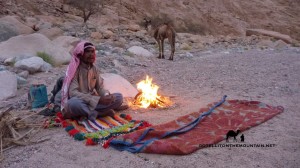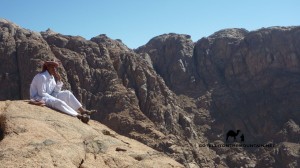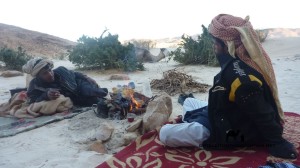Who’s Who?
 The Sinai has been part of Egypt since the Pharaohs, but in terms of its population, at least in the wilderness areas, it’s more a Bedouin land. The Bedouin are a people of nomadic descent; very different to mainland Egyptians. They settled here from Arabia and today they’re thought to number about 200,000 (mostly in North Sinai). Egyptian identity is tied up with a nation; by contrast, the Bedouin are a people of tribes. The tribe is key to Bedouin identity – nation states are seen as alien – and each tribe has its own lands, history and origins. The Sinai has about 23 tribes, with seven or eight in South Sinai. A bit is sketched out about each below; but bear in mind Bedouin oral tradition can be flexible. What’s here can be related differently!
The Sinai has been part of Egypt since the Pharaohs, but in terms of its population, at least in the wilderness areas, it’s more a Bedouin land. The Bedouin are a people of nomadic descent; very different to mainland Egyptians. They settled here from Arabia and today they’re thought to number about 200,000 (mostly in North Sinai). Egyptian identity is tied up with a nation; by contrast, the Bedouin are a people of tribes. The tribe is key to Bedouin identity – nation states are seen as alien – and each tribe has its own lands, history and origins. The Sinai has about 23 tribes, with seven or eight in South Sinai. A bit is sketched out about each below; but bear in mind Bedouin oral tradition can be flexible. What’s here can be related differently!
1. MUZEINA – The biggest tribe in South Sinai, with a territory encompassing Sharm, Dahab and half of Nuweiba. They came from the Hejaz mountains of Arabia, probably sometime in the 1500s, and remain especially close to the Alegat tribe today, having struck an alliance in their early days.
2 AULAD SAID – The Aulad Said live in the high, rugged mountain country south of St Katherine; one of the most remote, beautiful parts of the peninsula. Their holy man was Nabi Saleh, an early prophet mentioned in the Koran.
 3. JEBELEYA – This tribe lives mostly in the high mountains of the Sinai, in the town of St Katherine. Jebel means ‘mountain’ in Arabic; and literally, the Jebeleya are ‘The Mountain People’. They’re different from other Bedouin tribes of the Sinai – and other tribes anywhere for that matter – with a part of them tracing descent from European Christian soldiers sent to protect the Monastery of St Katherine 1500 years ago. Whatever their history, the Jebeleya are as Bedouin as anyone in looks and customs today.
3. JEBELEYA – This tribe lives mostly in the high mountains of the Sinai, in the town of St Katherine. Jebel means ‘mountain’ in Arabic; and literally, the Jebeleya are ‘The Mountain People’. They’re different from other Bedouin tribes of the Sinai – and other tribes anywhere for that matter – with a part of them tracing descent from European Christian soldiers sent to protect the Monastery of St Katherine 1500 years ago. Whatever their history, the Jebeleya are as Bedouin as anyone in looks and customs today.
4. GARARSHA – The Gararasha are a tribe from Wadi Feiran, one of the Sinai’s biggest wadis. It’s said they arrived many centuries ago, probably from the Hejaz. They’re one of the region’s smaller tribes today – just a few hundred strong – and have close historical ties with the Sowalha.
5. ALEGAT – The Alegat used to be a big, powerful tribe. Back in the 19th century, travellers reported finding a branch of them as far away as Nubia. They have close ties with the Muzeina and live on the west side of the Sinai today, near the Egyptian temple in the Serabit el Khadem area.
 6. HAMADA – A smal, little-known tribe. They’re said to be the oldest tribe in the Sinai, with bloodlines from the first native mining peoples of the peninsula. Today, they live in a few remote valleys near the tomb of a holy man called Sheikh Hashash, not too far from Serabit el Khadem.
6. HAMADA – A smal, little-known tribe. They’re said to be the oldest tribe in the Sinai, with bloodlines from the first native mining peoples of the peninsula. Today, they live in a few remote valleys near the tomb of a holy man called Sheikh Hashash, not too far from Serabit el Khadem.
7. SOWALHA – This tribe once claimed to be the oldest in the Sinai. Actually, that title probably goes to the Hamada or Jebeleya; but it is true the Sowalha were the most powerful for a long time. Their influence declined when they lost a war – fought over several generations – against the Alegat and Muzeina. Their territory is in the western part of the Sinai today; near Wadi Feiran.
8. BANI WASSIL – The Bani Wassil such a tiny tribe they’re rarely referred to as one of South Sinai’s tribes. Their territory is on the west side of the Sinai and they were here – as a bigger tribe – many centuries ago.
 AND FINALLY, THE TARABIN – The Tarabin are a big tribe whose territory begins in the northern half of Nuweiba. They have one branch in South Sinai, and another one in North Sinai. Actually, their tribal territory even runs over Egypt’s national border into Gaza, where more are found. Historically, they’re often not counted as one of the tribes of South Sinai; probably because they settled here later, or because of the strong ties they’ve always maintained with other Bedouin groups in the north.
AND FINALLY, THE TARABIN – The Tarabin are a big tribe whose territory begins in the northern half of Nuweiba. They have one branch in South Sinai, and another one in North Sinai. Actually, their tribal territory even runs over Egypt’s national border into Gaza, where more are found. Historically, they’re often not counted as one of the tribes of South Sinai; probably because they settled here later, or because of the strong ties they’ve always maintained with other Bedouin groups in the north.